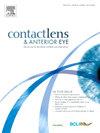使用角膜塑形镜时,后视区直径对角膜形态的影响。
IF 3.7
3区 医学
Q1 OPHTHALMOLOGY
引用次数: 0
摘要
研究目的本研究旨在比较佩戴不同后视区直径(BOZD)的角膜塑形镜(OK)后,角膜地形图评估中角膜形态特征的变化。这些变化包括角膜顶端力(ACP)、最大相对角膜屈光力(mRCRP)和治疗区直径(TZD)的变化比率:对复旦大学附属眼耳鼻喉科医院收治的133名近视儿童(平均年龄9.50 ± 1.23岁)的数据进行回顾性分析。所有参与者都配戴了同一品牌的切线设计OK镜(角膜屈光治疗,CRT)。根据角膜屈光度数(BOZD),患者被分为两组,分别为 5.0 毫米和 6.0 毫米。对基线、戴镜后1天、1周和1个月的角膜地形图进行分析,并比较两组患者的ACP、mRCRP和TZD的变化率:戴镜 1 天或 1 周后,ACP 的变化率在 BOZD 5.0 组和 6.0 组之间没有明显差异(分别为 P = 0.170 和 P = 0.113)。然而,戴镜 1 个月后,BOZD 5.0 组的 ACP 变化比明显大于 BOZD 6.0 组(P 结论:BOZD 5.0 组的 ACP 变化比明显大于 BOZD 6.0 组):在 CRT OK 镜片中,小的 BOZD 镜片能产生更快的角膜塑形、更大的 mRCRP 和更小的 TZD,这可能对减缓眼轴长度伸长有更好的效果。镜片参数也是影响 TZD 的一个因素。本文章由计算机程序翻译,如有差异,请以英文原文为准。
Influence of back optic zone diameter on corneal morphology with orthokeratology lenses
Objective
This study aimed to compare the changes in corneal morphological characteristics in corneal topography assessments performed after wearing orthokeratology (OK) lenses with different back optic zone diameters (BOZDs). These changes included the change ratios of the apical corneal power (ACP), the maximum relative corneal refractive power (mRCRP), and the treatment zone diameter (TZD).
Methods
Data from 133 children with myopia (average age 9.50 ± 1.23 years) treated at Fudan University Eye and Ear, Nose, and Throat Hospital were retrospectively analyzed. All participants wore the same brand of tangent-design OK lens (corneal refractive therapy, CRT). According to the BOZD, the patients were divided into two groups, of 5.0 and 6.0 mm BOZD, respectively. Corneal topography was analyzed at baseline, as well as 1 day, 1 week, and 1 month after wearing the lenses, and the change ratios of ACP, mRCRP, and TZD were compared between the two groups.
Results
The change ratio of the ACP did not differ significantly between the BOZD 5.0 and 6.0 groups after 1 day or 1 week of lens wear (P = 0.170 and P = 0.113, respectively). However, after 1 month of lens wear, the change ratio of the ACP in the BOZD 5.0 group was significantly larger than that in the BOZD 6.0 group (P < 0.001). After 1 month of lens wear, the mRCRP along the horizontal and vertical meridians was higher (P < 0.05) and the TZD was significantly smaller (P < 0.001) in the BOZD 5.0 group than in the BOZD 6.0 group.
Conclusion
In CRT OK lenses, a small BOZD lens can produce faster corneal shaping, a larger mRCRP, and a smaller TZD, which may have a better effect on slowing ocular axial length elongation. The lens parameters are also a factor affecting the TZD.
求助全文
通过发布文献求助,成功后即可免费获取论文全文。
去求助
来源期刊

Contact Lens & Anterior Eye
OPHTHALMOLOGY-
CiteScore
7.60
自引率
18.80%
发文量
198
审稿时长
55 days
期刊介绍:
Contact Lens & Anterior Eye is a research-based journal covering all aspects of contact lens theory and practice, including original articles on invention and innovations, as well as the regular features of: Case Reports; Literary Reviews; Editorials; Instrumentation and Techniques and Dates of Professional Meetings.
 求助内容:
求助内容: 应助结果提醒方式:
应助结果提醒方式:


